![]() Introduction
Introduction
![]() Cash Flows of a Dairy
Cow
Cash Flows of a Dairy
Cow
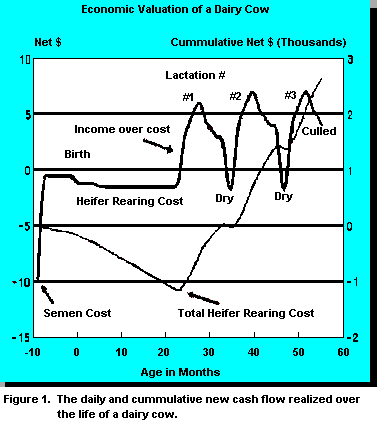
Profit may increase by lowering costs, increasing milk production, and/or by improving reproductive efficiency and shifting the entire cash flow curves to the left and decreasing the time period between peak cash flows. Reproductive efficiency, measured as the calving interval, influences time spent around the most profitable period of milk flow which is the first 100 days of lactation. In addition, litres of milk produced per day per herd lifetime is influenced by calving interval. Furthermore, cows culled for reproductive failure, that is excessive days open and not pregnant, and calves born per year also are influenced by the calving interval. Income associated with these cash flows contribute to the profitability of herd reproductive programs.
Simulation modelling techniques provide a useful tool to effectively evaluate the direct and indirect consequences of reproductive management programs. Data from a dairy may be used as a starting population and then income may be evaluated with varying management strategies over a planning period. Individual animals are moved forward through time where the status of each is modified with various events and management decisions. The economic consequence (cash flows) can then be tracked along with the performance and event changes. Dairy Oracle (Marsh et al, 1987) is a dairy herd simulation program that allows the user to enter management information regarding the operation of a dairy herd. The program then simulates the economic consequences of the entered management parameters for a six year time horizon using Monte Carlo simulation.
Improved reproductive efficiency dramatically changes the magnitude and time in which
cash flows are realized and thus economic value. Figure 2 shows the shifts in the cash
flow curves expected with an improved reproductive program. The difference in income
from baseline represents the marginal profit associated with improved reproductive
efficiency. 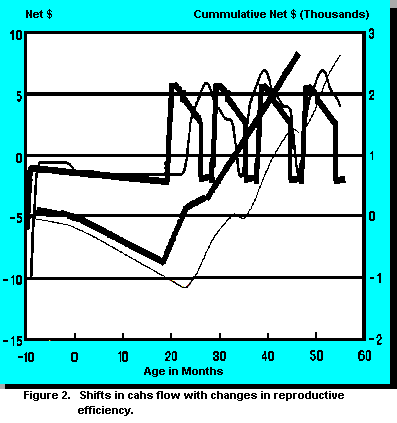
Improvement in heat detection rates from .50, typical on most farms, to .80 for first service will increase net return per cow about $50.00 above costs. This represents about a 7% increase in return, a rate equivalent to increasing production about 450 kg.
Reproductive programs are implemented to assure a majority of cows in the herd realize an optimal CI, cows are culled for desired reasons, labour is used efficiently for heat detection, cows with reproductive disease receive medical attention within regulatory guidelines, and semen is allocated to populations of cows effectively. The veterinarian is an ideal person to coordinate, program, evaluate, and monitor herd reproductive performance. What constitutes an effective herd reproductive program?
![]() Reproductive
Programs
Reproductive
Programs
![]() Semen Allocation
Semen Allocation
Semen from sires varies in price and genetic quality. In general, better bulls have more expensive semen. Selection response is equal to the intensity of selection times the accuracy of selection times the genetic variation of the selected trait. Due to the intensity of selection for choosing bulls in AI programs and the greater accuracy of choosing superior bulls, 70 to 80% of the selection response for production in dairy herds is related to the male program. Thus, bull selection in a dairy herd is the major component of genetic progress. Semen selection will have a direct affect on genetic gain and cost of the breeding program. Computer programs are available which enable a producer to select bulls to maximize desired genetic gain at the least cost.
However, in addition to semen selection, semen allocation will influence the cost of the
breeding program. Return from investment in semen is only realized when a milking
daughter from that bull stands in the herd. The probability of obtaining a milking daughter
in a herd from any one mating is a function of conception, sex ratio, and survival to
calving, which includes embryonic mortality, calf mortality, reproductive failure in heifers,
and calf losses at first calving. Sex ratio is typically 50/50, male and female. Thus
considering conception and survival, it can be seen in the following table, that probabilities
of a milking daughter from any given insemination are quite low, even at high rates of
conception and survival.
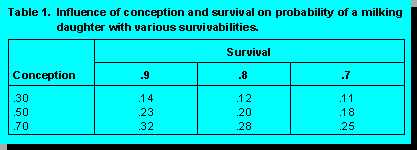
Even with very good conception (.7) and excellent survival to calving (.9), the probability of a milking daughter is only .32 from any one insemination. This influences total semen cost, as it determines the total number of inseminations necessary to achieve a milking daughter. Different populations of cows in a herd will have varying CR and thus will have different efficiencies of semen usage. Typically virgin heifers have 65% CR, whereas milking cows with no pathology may have a CR of 40 to 60%, and problem animals may have a CR of 20 to 35%. Consider these different CR on probability of a milking daughter and total services needed to achieve a milking daughter.
As seen in Table 2, the cost of semen to get a milking daughter is 1.8 times higher in
problem cows than in virgin heifers, if $15 semen is used in both groups. Semen would
have to cost $8.34/straw in the problem cows to have the same total cost as the virgin
heifers. 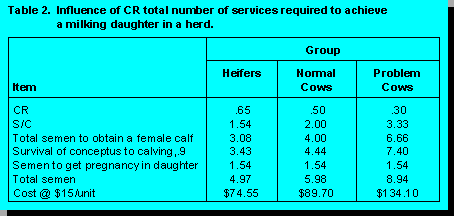 Within a herd, semen cost can
be reduced by allocating the best semen to highly fertile cows, particularly virgin heifers;
the cheapest semen should be allocated to potential problem cows. Problem cows should
be identified as those with postpartum complications, feet and leg problems, and cows
with excessive body condition loss. Veterinarians can help farms identify potential low
fertility cows and help with decisions to allocate semen to these groups.
Within a herd, semen cost can
be reduced by allocating the best semen to highly fertile cows, particularly virgin heifers;
the cheapest semen should be allocated to potential problem cows. Problem cows should
be identified as those with postpartum complications, feet and leg problems, and cows
with excessive body condition loss. Veterinarians can help farms identify potential low
fertility cows and help with decisions to allocate semen to these groups.
As with semen allocation, farms may improve returns on their reproductive program by allocating labour to specific areas. For example, heat detection for first insemination versus repeat inseminations does not have the same effect on herd profit from reproduction and should not receive the same weight.
![]() Reproductive Performance
Reproductive Performance
Age at first calving and calving interval (CI) are determined by the VWP, HDR, CR and
pregnancy maintenance to term (6). Cows and heifers become pregnant from the VWP
as a function of the HDR and CR. These terms may be combined into one term, the
pregnancy rate (PR, PR=HDR*CR), which represents the proportion of cows that
become pregnant each estrous cycle. Pregnancy rate determines the "speed" at which
cows become pregnant from the VWP (Figure 3).
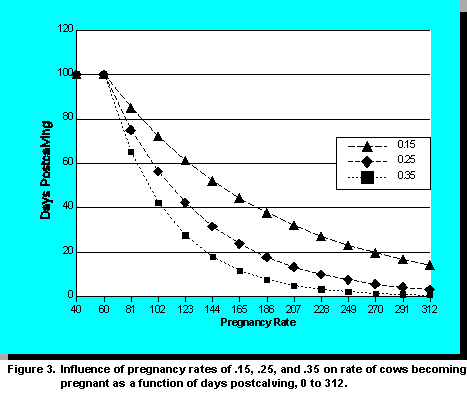
If PR equals .25 (any combination of HDR*CR that equal .25), it requires five estrous cycles, 105 days, to get 77% of cows pregnant from the VWP. Twenty-three percent of cows will still be open. If PR is .15, less than 60% of cows are pregnant after five estrous cycles. With a PR of .35 88% of cows will be pregnant after five estrous cycles with only 12% still open. More cows become pregnant sooner as PR increases. Cows open over 120 d are at risk of being culled for reproductive failure, particularly to maintain an acceptable CI in the herd. Low PR increases the number of cows culled for reproductive failure due to an unacceptably long CI.
Profit from reproduction is a function of PR. Using DAIRY ORACLER, it is possible to calculate what the optimal PR should be for a herd. Using inputs of milk price at $10.50, calf value at $75, cull cows at $500, semen cost at $10.00/straw, and replacement heifer costs at $1,000; profit per cow per year as a function of PR appears in Figure 4.
Profit increases with increasing PR from .1 to .85. However, the largest increases occur as PR increases from .1 to .25. The curve flattens out when PR is above .35 to .45. Profit associated with reproduction will be maximal when PR is .35. Actual returns will vary with milk price, calf value, cull prices, and replacement costs, but the point is that herd programs should strive to achieve PR of .35. The second point is that cows in the herd with low CR, such as cows with metritis, ketosis, retained placenta, etc., may have lower marginal returns for two reasons: increased drug and veterinary costs and reduced PR due to lower CR. If HDR is not increased to compensate the reduced CR, profits on these cows is greatly decreased. In addition, costs need to be controlled in these cows so income curves do not significantly fall below that of normal cows.
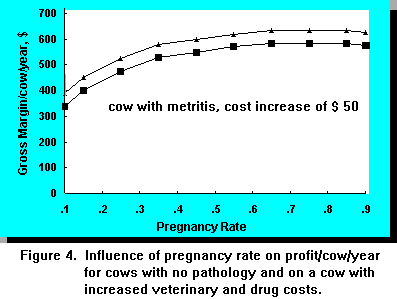 Groups of cows in the herd with potential for reduced fertility should be identified so
reproductive programs can be structured to optimize returns in these cows. Often cows
with reproductive disorders have lower PR (1). Yet these cows also have higher costs due
to increased veterinary, breeding fees, and labour for treatment and examinations. This
means that more money has been spent on these cows with lower potential returns. Often
these cows have low PR despite therapy (12). Cows with poorer reproductive potential
need to be identified and managed so costs are reduced.
Groups of cows in the herd with potential for reduced fertility should be identified so
reproductive programs can be structured to optimize returns in these cows. Often cows
with reproductive disorders have lower PR (1). Yet these cows also have higher costs due
to increased veterinary, breeding fees, and labour for treatment and examinations. This
means that more money has been spent on these cows with lower potential returns. Often
these cows have low PR despite therapy (12). Cows with poorer reproductive potential
need to be identified and managed so costs are reduced.
Many combinations of HDR and CR are possible to achieve a .35 PR. HDR may be partitioned into heat detection for first insemination (PREHDR) and heat detection for repeat insemination (POSTHDR). Each of these inputs contributes to reproductive efficiency. However, these inputs may not have the same magnitude of effect on CI, calves born per year (CALVYR), and culls per year (CULLYR).
The worst CR and HDR possible is 0, which indicates total failure. The best they can be is
1.0 (100%), which is often biologically infeasible. However, we can use these extremes to
examine the impact PREDHR, POSTHDR, VWP, and CR have on reproductive
performance. Although heat detection accuracy influences CR, combinations of these
parameters will still be between 1.0 and 0. Therefore, HDR and CR can be treated as
independent probabilities varying from .1 to 1.0. Most farms have HDR and CR between
.3 to .6. However, to demonstrate how these indices determine CI and culling, all
combinations of these parameters for PREHDR, POSTHDR, and CR were used to
simulate reproductive efficiency in a herd of 100 cows with a VWP of 40, 60, or 80 d.
Breeding period encompassed 10 estrous cycles from the VWP and 5 possible services
were allowed. Cows open after 10 estrous cycles were considered culled for reproductive
failure. A total of 3000 simulations were performed. Results are in Table 3.
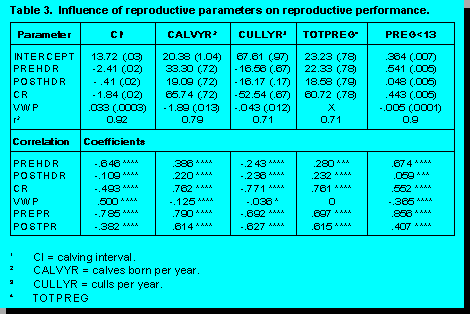
Table 3 presents coefficients for effects of reproductive management on CULLYR, CALVYR, CI, and cows pregnant after 115 d (GT13) in milk for a 100 cow herd. Heat detection for first insemination and CR are the most important variables influencing reproductive efficiency. Heat detection for repeat insemination was significant, but accounted for less of the variation than PREHDR and CR. Voluntary waiting period only influenced CALVYR and CI (reducing CI by .3 m for 10 d earlier breeding) and had no effect on CULLYR and GT13, due to the fixed breeding period used in this model. Pregnancy rate for first insemination combines the efficiency of PREHDR and CR on reproductive efficiency and represents cows pregnant at first service. Pregnancy rate for first insemination explained 79% of the variation in CI, 64% of the variation in CALVYR, 54% of the variation in GT13, and 48% of the variation in CULLYR. Thus controlling PREHDR and CR are the most important factors influencing CI, CALVYR, and GT13. Farms should allocate major efforts to PREHDR and CR to achieve the greatest returns on investment in the reproductive program.
![]() Herd Reproductive
Programs
Herd Reproductive
Programs
Many factors influence CR; these include cow, management, environment, and inseminator-bull factors. Therefore CR is difficult to control without a thorough analysis of factors contributing to reduced CR. Thus, it is essential that PREHDR be managed by the reproductive program. Increasing PREHDR can offset low CR, up to a point, since pregnancy rate is a function of HDR*CR.
The most important monitoring point is days to first insemination, not average days to first service, but the proportion of cows inseminated by 21 d following the VWP. Over 70 to 80% of cows need to be inseminated by 21 d after the VWP if the reproductive program is to function efficiently. Secondly, CR in cows first inseminated needs to be at least 35%, to achieve a PR of .35. Thirdly, POSTHDR can be controlled through visual observation, consistent rectal palpation for pregnancy at 35 d (4) and milk progesterone testing at 21 d postbreeding (4, 5). Typically, on most farms, 25% or more of interbreeding intervals are over 48 d. With a consistent, timely pregnancy exam at 35 d this can be reduced to less than 15%. With these factors in place, average indices of CI and days to first breeding will be at or below typically reported goals, culls for reproductive failure will be reduced, and profit from reproduction will be maximized.
Prebreeding HDR can be improved by synchronizing cows with prostaglandin. Table 5 presents a schematic of estrus in 21 cows over a 21 d period. If estrus detection was .5, 10 to 11 cows would be observed in heat over this 21 day period. Prostaglandin (PGF) can induce estrus in cows 7 to 16 d postestrus. A majority of cows will be in estrus in less than 7 d from the shot (7, 8, 31, 32). Cows not seen in heat can be injected 14 d later and re-synchronized. More cows will be responsive to the second injection on a 14 d interval than an 11 d interval (95% versus 75%). This increases potential heats to 37 in a 21 d period (Table 5). With a HDR of .5 then 18 heats could potentially be detected, improving HDR to .85.
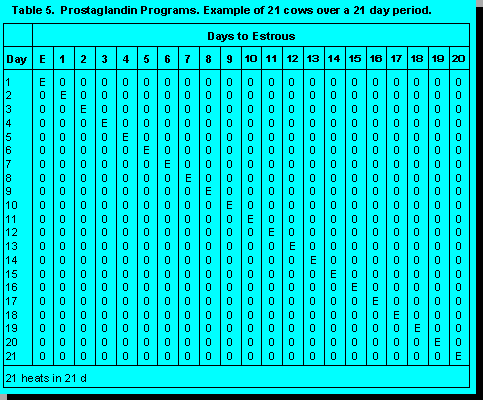
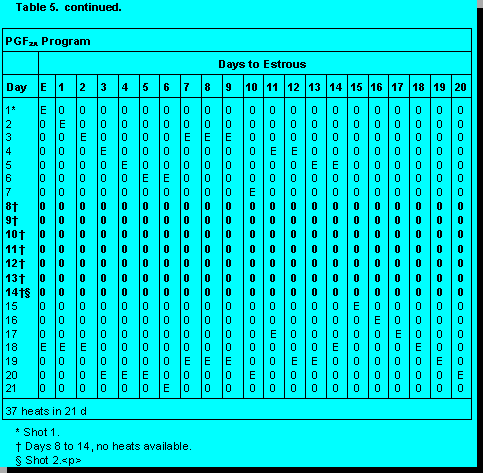
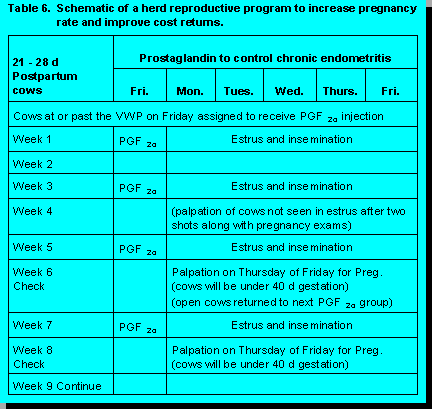
Cows should be assigned to receive PGF1 based on a consistent schedule. They should not be palpated to pre-select for PGF1 treatment or prior to receiving PGF2. After the PGF1 shot, we expect a potential 70% of cows in heat (8,9). After the second PGF2, we expect close to 100% of cows in heat. Palpation selection will misallocate cows reducing the synchronization at the second injection. Palpation should be done for pregnancy exam in the off week from PGF injection, as this will result in most cows at 35 d postbreeding. At this time, if cows are not seen in heat after PGF2, they can be palpated for ovarian status. They should have a CL3, indicating missed estrus. These cows then are reassigned to the next PGF injection and can be assigned to appointment breeding. We have found this program to be very effective in improving PREHDR and controlling POSTHDR.
Using PGF every 14 d on a consistent basis results in herd synchronization. Synchronization every 14 d allows farm management to group estrus observation on an every other week basis. Injections every week to cows not seen in estrus are costly, because many cows will not have a responsive CL after the first shot. Additionally, every week injection induces two synchronous waves of estrous cows, one week out of phase with each other. The farm cannot use timed insemination with weekly prostaglandin injections. Weekly injections will more than double the use of prostaglandin to get a cow inseminated over a program that runs every other week.
Rectal palpation for pregnancy at 35 versus 45 d returns an additional $2.63 if open cows are ensured insemination at next estrus (5). Early palpation is effective if it is done on a routine basis, which means frequency of visits have to ensure cows are palpated consistently 35 d (32 to 39 d) post breeding. Palpations should focus on maintaining pregnancy checks consistently prior to 42 d, to anticipate estrus return.
Several studies have indicated the cost benefit of milk progesterone kits for identifying open cows at 21 d post-insemination (5, 7). Tests have to be performed consistently close to insemination and three weeks later to be interpretable. Tests could be done on the Monday following prostaglandin injection to identify cows coming in heat. Cows with low progesterone would be watched closely for estrus that week. If inseminated, three weeks later milk progesterone assays would be run for return estrus. Kits have to be over 80% accurate at identifying cows with progesterone under 1 ng/ml and under $5/test. Kits work well to identify low progesterone cows not high progesterone cows. Follow up with rectal palpation at 35 d to confirm pregnancy in cows with high progesterone. Due to the consistent progesterone testing, this method will only be practical with a synchronization program.
![]() Example of a Herd
Program
Example of a Herd
Program
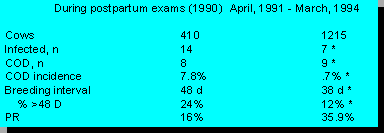
Cows infected at pregnancy exam, or after 40 d postcalving are lower since we began routine prostaglandin injections at 28 d postcalving. Cows with COD are reduced and PR is at our goal of 35% or higher. This herd has been able to sell replacements for dairy purposes and maintain a higher milking herd since we began this program than when they did weekly postpartum exams.
![]() References
References